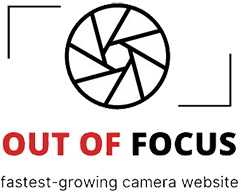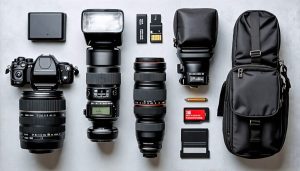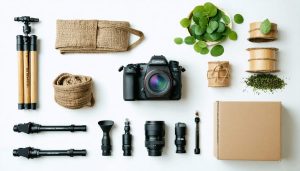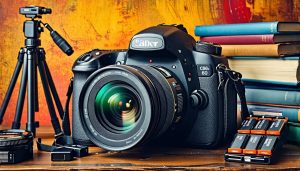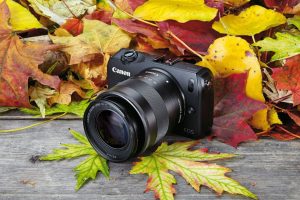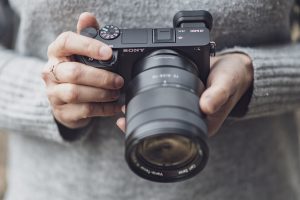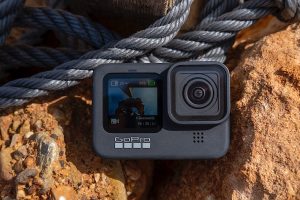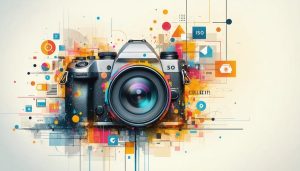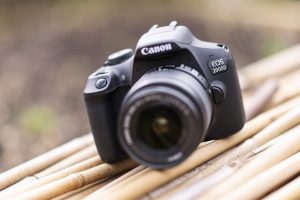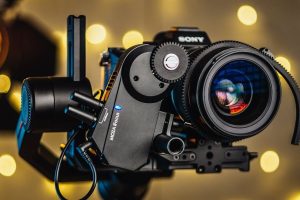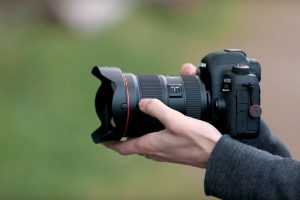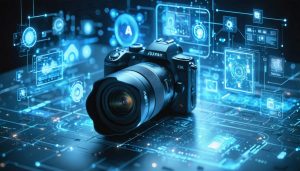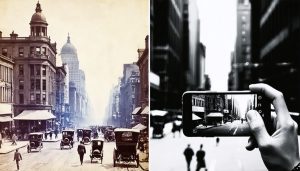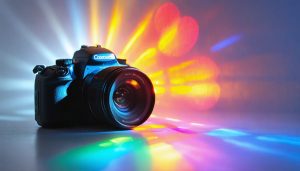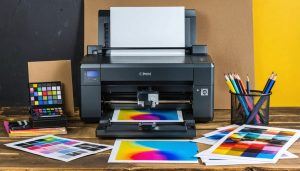
Dive into the world of used photography equipment with confidence and save thousands without sacrificing quality. Smart photographers know that pre-owned gear often delivers professional-level performance at fraction of retail prices – but only when you know exactly what to look for. Whether you’re choosing the right camera or expanding your lens collection, the secondary market offers incredible opportunities alongside potential pitfalls. From meticulously inspecting shutter counts on DSLRs to identifying authentic professional gear among counterfeits, this guide reveals insider techniques for navigating the used equipment landscape. Master the art of negotiation at camera shops, decode cryptic online listings, and learn which brands hold their value best over time. With proper knowledge and careful evaluation, your next piece of pre-owned gear could become the cornerstone of your creative toolkit.
Why Consider Used Photography Equipment?
Cost Savings vs. New Equipment
One of the most compelling reasons to consider used photography equipment is the significant cost savings compared to buying new. A professional-grade DSLR or mirrorless camera that retails for $3,000 new can often be found in excellent condition for $1,500-1,800 on the used market – a savings of up to 50%. This pattern holds true across most photography gear categories.
Lenses, in particular, offer exceptional value in the used market. Quality glass tends to retain its optical performance for decades when properly cared for, and premium lenses typically hold their value remarkably well. A used professional lens might sell for 30-40% less than its new counterpart while delivering virtually identical image quality.
The savings become even more apparent when building a complete kit. A photographer could potentially acquire two professional-grade used lenses and a high-end used camera body for the price of a single new camera body. This makes it possible to access professional-level equipment on an enthusiast’s budget.
Consider this real-world example: A new 70-200mm f/2.8 lens might cost $2,200, while a two-year-old used version in excellent condition could be found for around $1,400. The $800 saved could then be invested in additional gear or accessories, helping photographers build more comprehensive kits without compromising on quality.
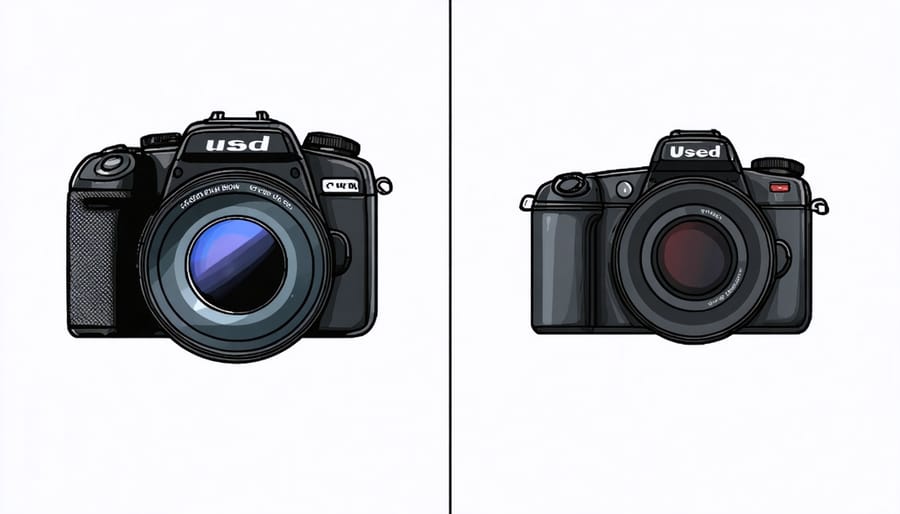
Professional-Grade Gear at Amateur Prices
One of the most compelling reasons to explore the used market is the opportunity to access professional-grade equipment at significantly reduced prices. A three-year-old flagship camera body might sell for half its original price while still delivering exceptional image quality and performance that rivals current models.
Consider this: a used Canon 5D Mark IV or Nikon D850 could cost you the same as a new entry-level camera, yet provide superior weather sealing, faster autofocus, and better low-light performance. Similarly, premium lenses that typically cost thousands new become much more accessible on the second-hand market, often retaining their optical excellence for decades.
This value proposition extends beyond just bodies and lenses. Professional lighting equipment, tripods, and specialized accessories become attainable when bought used. A photographer might start with a modest budget but end up with a kit that could serve in professional settings.
The beauty of buying used lies in the depreciation curve. Most photography gear experiences its steepest price drop in the first two years, after which the value stabilizes. This means you can often use high-end equipment for a few years and resell it for nearly the same price you paid, making it an incredibly cost-effective way to experience premium gear while developing your skills.
Where to Find Quality Used Equipment
Reputable Online Marketplaces
When it comes to purchasing used photography equipment online, several reputable marketplaces have established themselves as trusted sources within the photography community. B&H Photo’s used department and KEH Camera stand out as industry leaders, known for their rigorous testing processes and reliable grading systems. These platforms typically offer warranties on used gear, providing peace of mind for buyers.
MPB.com has gained significant popularity among photographers for its transparent condition ratings and seamless buying experience. They thoroughly inspect all equipment and provide detailed photographs of the actual item you’ll receive, not just stock images. Adorama’s used department also maintains high standards for quality control and often offers competitive prices on pre-owned gear.
For peer-to-peer transactions, Fred Miranda’s Buy/Sell Forum has built a strong reputation within the photography community. While it requires more due diligence as a buyer, the forum’s feedback system helps establish trust between members. Similarly, Reddit’s r/photomarket provides a platform for direct sales, though it’s essential to verify sellers and follow the community’s safety guidelines.
eBay remains a viable option, particularly when purchasing from established camera stores with high feedback ratings. Look for sellers who specialize in photography equipment and provide detailed item descriptions and multiple photos. Remember to check return policies and payment protection features, regardless of the platform you choose.
Local camera shops often maintain online inventories of their used equipment, combining the convenience of online shopping with the option to inspect items in person before purchasing. Many offer shipping nationwide, expanding your options beyond your local market.
Local Camera Shops and Trade Shows
While online marketplaces offer convenience, local camera shops and trade shows provide unique advantages that digital platforms simply can’t match. Walking into a physical store allows you to handle equipment firsthand, test its functionality, and thoroughly inspect for any issues before making a purchase. This hands-on experience is invaluable, especially when investing in used gear.
Local camera shops often build strong relationships with their communities, offering personalized advice and standing behind their pre-owned inventory with warranties or return policies. Many shops also provide expert staff who can answer technical questions and share insights about specific equipment based on years of experience.
Photography trade shows and swap meets are excellent venues for finding used equipment deals. These events bring together multiple sellers, creating healthy competition and opportunities for negotiation. You’ll often find rare or vintage items that rarely appear online, and the face-to-face interaction allows for meaningful discussions about the gear’s history and condition.
Another significant advantage of buying locally is the potential for building lasting relationships with fellow photographers and dealers. These connections can lead to future deals, trading opportunities, and valuable networking within the photography community. Many local shops also offer repair services and can provide maintenance advice specific to your purchased equipment.
Remember to take advantage of the “try before you buy” opportunity when shopping locally. Test the autofocus, check for sensor spots, and verify all mechanical functions work smoothly. This immediate feedback can save you from the disappointment of discovering issues after an online purchase arrives.

Essential Inspection Checklist
Camera Body Inspection Points
When inspecting a used camera body, start with the exterior condition. Look for dents, scratches, or signs of impact that might indicate internal damage. Pay special attention to the grip area, as worn rubber can suggest heavy usage. Check that all buttons and dials move smoothly and respond correctly.
The lens mount is crucial – examine it for scratches, bent pins, or signs of wear. These could affect lens communication and autofocus performance. The mirror box in DSLRs should be clean and free from damage, while mirrorless cameras should have pristine sensors without scratches or dust spots.
Test the shutter mechanism by taking photos at various speeds. Listen for unusual sounds and check for consistent operation. The shutter count is particularly important – think of it as a camera’s mileage. Most modern cameras can handle hundreds of thousands of actuations, but a high count might indicate approaching end-of-life.
Don’t forget to inspect the battery compartment for corrosion and the memory card slots for damage. Test all ports, including USB and HDMI connections. The LCD screen should be scratch-free and fully functional, with no dead pixels or color issues. The viewfinder should be clear, with intact eyecups and proper diopter adjustment.
Finally, check the weather sealing gaskets if present, and ensure the hot shoe is undamaged. These inspection points will help you make an informed decision about your potential purchase.
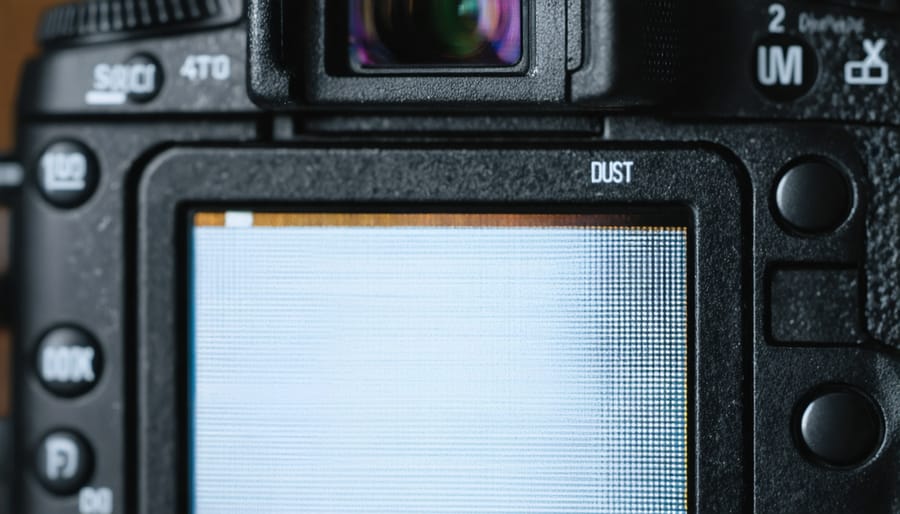
Lens Assessment Guide
When evaluating a used lens, several critical factors demand your attention. First, examine the glass elements for scratches, fungus, or internal dust. While minor dust specks won’t significantly impact image quality, deep scratches or fungal growth are deal-breakers. Follow these detailed lens inspection tips to ensure you don’t miss anything crucial.
Test the focus ring’s smoothness – it should turn without grinding or catching. The same goes for the zoom mechanism in zoom lenses; any resistance or unusual sounds could indicate internal damage. Check that aperture blades move freely and form a perfect polygon when stopped down, without oil or sticky residue.
Pay special attention to the lens mount. Look for signs of wear, bent pins, or corrosion. These issues can affect communication between the lens and camera body or even prevent proper mounting. Electronic contacts should be clean and free from oxidation.
Don’t forget to test autofocus functionality. Listen for unusual sounds and verify focus accuracy across different distances. If possible, take test shots at various apertures to check for proper exposure and sharpness.
Finally, request service history and original packaging when available. A well-maintained lens with documentation often proves a better investment than a cheaper option with unknown history.
Testing Electronics and Functionality
Before making a purchase, thoroughly testing the electronics and functionality of used photography equipment is crucial. Start by checking the basics: power up the camera and listen for any unusual sounds. The LCD screen should display clearly without dead pixels or color issues.
Check all buttons, dials, and switches to ensure smooth operation without stickiness or resistance. Test the memory card slot by inserting and removing a card several times. The battery compartment should be free from corrosion, and the contacts should be clean and undamaged.
For cameras with live view or electronic viewfinders, verify that the display responds quickly and accurately. Test the autofocus system in different lighting conditions and focus modes. The shutter should fire promptly without hesitation or unusual sounds across all speeds.
When testing lens functionality, check that the aperture blades move smoothly and the zoom and focus rings operate without grinding or catching. Listen for any internal rattling when gently shaking the lens.
Take several test shots at different settings to verify proper exposure and image quality. Review these images at full size on a computer if possible. Check for sensor dust or damage by photographing a plain white surface at f/16 or smaller.
Finally, test all ports and connections, including USB, HDMI, and flash sync. Don’t forget to verify that the hot shoe works correctly if you plan to use external flash units.
Red Flags and Deal Breakers
Common Defects to Avoid
When shopping for used photography equipment, certain defects should immediately raise red flags. Fungus growth inside lenses is a serious issue that’s often irreversible and can spread to other equipment. Look for telltale signs like web-like patterns or fuzzy spots between lens elements.
Shutter problems are another critical concern. Test the camera at various speeds and listen for unusual sounds or delays. If the shutter sticks or produces inconsistent exposures, walk away. Similarly, autofocus issues like hunting, grinding noises, or complete failure indicate potentially expensive repairs.
Sensor damage is non-negotiable. Check for dead pixels, scratches, or oil spots by taking test shots of a plain white surface. LCD screen damage, including dead pixels or color bleeding, can significantly impact your shooting experience and should be avoided.
Physical damage like deep scratches, dents, or signs of impact near vital components could indicate internal problems. Be especially wary of water damage markers, corroded battery compartments, or sticky residue from attempted repairs.
Electronic issues such as unreliable connections, intermittent power failures, or error messages typically suggest underlying problems that may worsen over time. Memory card errors or corrupted files during testing should also prompt serious consideration before purchasing.
Remember, cosmetic wear is normal for used equipment, but functional defects can render a bargain worthless.
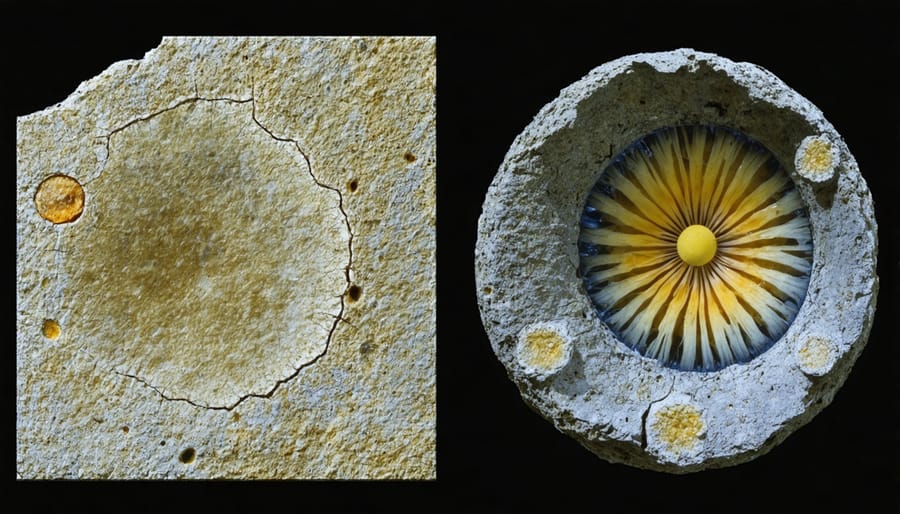
Warning Signs in Seller Behavior
When shopping for used photography equipment, certain seller behaviors should raise immediate red flags. If a seller is reluctant to provide detailed photos of the equipment or avoids answering specific questions about its condition, this could indicate they’re hiding potential issues. Be wary of sellers who refuse to demonstrate that the equipment is fully functional or won’t allow in-person inspection before purchase.
Watch out for listings with suspiciously low prices compared to market value. While great deals exist, if something seems too good to be true, it probably is. A seller pressuring you to make an immediate decision or demanding unusual payment methods (like wire transfers or cryptocurrency) should also make you pause.
Pay attention to how the seller communicates. Professional sellers should be knowledgeable about their products and respond to inquiries promptly and clearly. If they can’t provide basic information about the equipment’s history, usage, or technical specifications, consider this a warning sign.
Be cautious of sellers who can’t or won’t provide original documentation, especially for high-end equipment. Missing warranties, manuals, or receipts could indicate stolen goods or counterfeit items. Similarly, if a seller’s listing contains stock photos instead of actual pictures of the item, or if they’re unwilling to provide additional photos upon request, you might want to look elsewhere.
Investing in used photography equipment can be a smart way to build your gear collection while staying within budget. As we’ve explored throughout this guide, successful purchases depend on thorough research, careful inspection, and buying from reputable sources. Remember to always test equipment thoroughly before purchasing, check for warranties or return policies, and don’t hesitate to ask sellers detailed questions about the item’s history and condition.
For beginners, we recommend starting with entry-level used gear from well-known brands and gradually upgrading as your skills develop. Our comprehensive camera buying guide can help you make informed decisions about specific models.
Whether you’re shopping at local camera stores, online marketplaces, or through photography forums, always prioritize equipment condition over getting the absolute lowest price. A slightly higher investment in well-maintained used gear often proves more economical than dealing with repairs or replacements down the line. With proper research and patience, you’ll find that the used photography market offers excellent opportunities to acquire quality equipment that meets both your creative needs and financial goals.
